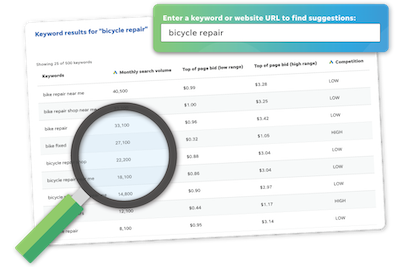Popular Keyword – Credit Card Keywords
Search Popular Keywords in Your Industry
These are the most popular suggestions for Credit Card Keywords generated by WordStream’s Free Keyword Tool. To get have all of these keywords sent to you, simply enter your Email address and click “Email Keywords” below.
Your keywords are on the way to your inbox!
Credit Card Marketing Tips and Tricks
Despite what the loud guy in the cubicle next to you will say, cryptocurrencies like Bitcoin aren’t dominant. Increasingly prominent? Sure. But Loud Gary clearly hasn’t looked at the numbers.
According to a 2018 report by Supermoney, credit cards are the most popular form of credit and the second-favorite payment method (behind debit cards) among Americans. Gross national credit card debt is at record highs, but it’s growing in stride with GDP, which indicates that debt is stable for now. Plus, delinquency rates remain unusually low and credit scores are soaring. While talks of rising debt may cause memories of 2008 to flare up, the American credit card market should not inspire any panic just yet.
Let’s talk demographics. Compared to renters, homeowners borrow more from their credit card companies and are more likely to carry a balance. This makes sense—homeowners tend to have higher incomes and better credit scores.
You may intuit that urban consumers rely more heavily on credit cards, but that’s not the case. Rural debt and urban debt are essentially equal, and consumers from the two areas are equally likely to carry credit card balances.
Finally, millennials are not the biggest fans of credit cards. They hold considerably less debt than older generations, and 70% of them prefer to use debit cards. Again, this is expected behavior. Millennials were either approaching or beginning adulthood when the 2008 crisis hit, and it clearly impressed them with an aversion to debt. Plus, with student loan debt also at record highs, it makes sense that recent graduates would be hesitant to incur even more.
So, what does all this information mean to credit card marketers?
First things first: it’s wise to focus your pay-per-click (PPC) ads on suburban prospects. Consumers living in these areas are demonstrably more qualified to take on lines of credit. It’s important to target your ads at the most relevant audiences possible to make sure you maximize your click-through rates (CTRs)—and, by extension, your Quality Scores and ad ranks. Ultimately, this geographical targeting strategy will drive more conversions and reduce costs per click (CPCs).
You can supplement this with income targeting and demographic targeting, too. As you can imagine, we advise that you aim for more affluent prospects on the older side. Once again, a successful PPC campaign is one that targets a highly relevant audience. Taking on a credit card isn’t terribly feasible for someone in a low-income household or a recent college graduate with tens of thousands in student loan debt. Don’t advertise to those who won’t click or convert.
In recent years, what draws consumers to a particular credit card company has become increasingly clear: rewards. Sure, people still take into account things like interest rates, flexibility, and customer service. But, unless you can offer generous cash-back rebates or travel points, you’re going to fall behind your competition.
This trend is crucial when it comes to crafting your PPC ads. Be sure to emphasize whatever rewards you offer as prominently as possible. Driving clicks is all about giving the prospect what he or she wants. A headline like “Sign Up Today for Low Interest Rates!” simply isn’t as compelling as “Get Your Free Travel Points Today!” Even with Google granting advertisers more space on the search engine results pages (SERPs), you’re still working with limited real estate. Optimize your headlines and make the most of what you have.
For more PPC advertising tips, visit the WordStream blog.
BUSINESS KEYWORDS
- Accounting Keywords
- Affiliate Keywords
- Auto Insurance Keywords
- B2B Ecommerce Keywords
- B2B Keywords
- Biotechnology Keywords
- Business Keywords
- Business Management Keywords
- Business Travel Keywords
- Construction Keywords
- Credit Card Keywords
- Debt Keywords
- Entertainment Keywords
- Finance Keywords
- Human Resources Keywords
- Insurance Business Keywords
- Internet Security Keywords
- Management Keywords
- Office Supplies Keywords
- Online Payment Solutions Keywords
- Software Keywords
- Startup Keywords
- Web Hosting Keywords
CONSUMER KEYWORDS
- Art Keywords
- Automotive Keywords
- Casino Keywords
- Cell Phone Keywords
- Computer Keywords
- Dating Keywords
- Ecommerce Keywords
- Electronics Keywords
- Email Keywords
- Fashion Keywords
- Golf Keywords
- Hotel Keywords
- Internet Keywords
- Jobs Keywords
- Law Keywords
- Mortgage Keywords
- Music Keywords
- Online Stores Keywords
- Pest Control Keywords
- Photography Keywords
- Plumbing Keywords
- Real Estate Keywords
- Restaurants Keywords
- Shoes Keywords
- Travel Keywords
- Wedding Keywords
FINANCE KEYWORDS
HEALTH & WELLNESS KEYWORDS
MISCELLANEOUS KEYWORDS
- Aerospace Keywords
- Agriculture Keywords
- Best Travel Keywords
- Coffee Keywords
- Dog Training Keywords
- Education Keywords
- Environmental Keywords
- Food & Beverage Keywords
- Forex Keywords
- Gifts Keywords
- Home Based Business Keywords
- Home Improvements Keywords
- Internet Games Keywords
- iPhone Keywords
- Jewelry Keywords
- Landscaping Keywords
- Legal Keywords
- Luggage Keywords
- Pharmaceutical Keywords
- Poker Keywords
- Retail Keywords
- School Education Keywords
- Solar Energy Keywords
- Transporation Keywords
- Women Fashion Keywords
- Work From Home Keywords

